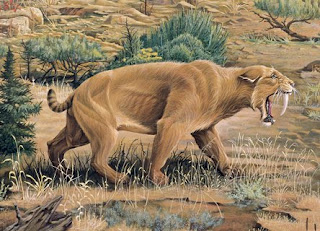
The social pattern of this cat is unknown. It has been suggested, based on the abundance of S. fatalis fossils in proportion to prey animals trapped in the La Brea tar-pits,[7] that they were packs of scavengers, lured in by the distress calls of trapped prey. This possibility was tested in 2008 by Chris Carbone (of the Zoological Society of London), who documented the responses of African predators of the Serengeti and Kruger National Park to recorded distress calls of prey species; it was determined that playbacks of prey sounds attract social carnivores, but not solitary hunters.[8] Additionally, some fossils show healed injuries or diseases that would have crippled the animal. Some palaeontologists see this as evidence that saber-toothed cats were social animals, living and hunting in packs that provided food for old and sick members. Living in groups might also allow more effective competition with social lions and wolves. The canine teeth and body size of Smilodon were about the same in both male and female cats. This suggests that one theory about their teeth – that they were used by males to attract mates – is incorrect.
No comments:
Post a Comment